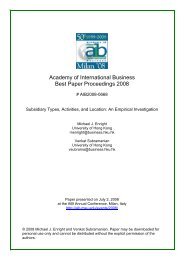AIB 2012 Conference Proceedings - Academy of International ...
AIB 2012 Conference Proceedings - Academy of International ...
AIB 2012 Conference Proceedings - Academy of International ...
Create successful ePaper yourself
Turn your PDF publications into a flip-book with our unique Google optimized e-Paper software.
SUNDAY<br />
The purpose <strong>of</strong> this paper is to develop a marriage metaphor model for the sociocultural integration in<br />
international mergers and acquisitions (M&As) based on a critical review and integration <strong>of</strong> the literature on the<br />
topic. M&As are <strong>of</strong>ten referred to as "marriages" between organizations. Building on this metaphor, the<br />
forwarded model suggests that the sociocultural integration process consists <strong>of</strong> three interrelated phases: the<br />
dating, mating, and creating periods. Extant research focuses primarily on the pre-M&A contingency and post-<br />
M&A process periods, which correspond to the dating and creating phases, respectively, and treats these<br />
research streams in relative isolation. This paper attempts to integrate these streams <strong>of</strong> research in the contexts<br />
<strong>of</strong> both organizational and national cultures, and further sets out to shed light onto the third, under-researched<br />
closing period, which corresponds with the mating phase in the forwarded model. In so doing, this paper<br />
aspires to conceptualize a more encompassing and inclusive model in order to gain a better understanding<br />
about the sociocultural integration process in M&As. Practical and scholarly implications <strong>of</strong> this perspective are<br />
discussed. (For more information, please contact: Daniel Rottig, Florida Gulf Coast University, USA:<br />
drottig@fgcu.edu)<br />
Clusters and Regional Management Structures <strong>of</strong> French Multinational Companies in Asia<br />
Johannes Schaaper, Bordeaux Management School<br />
Bruno Amann, University <strong>of</strong> Toulouse III<br />
Jacques Jaussaud, University <strong>of</strong> Pau<br />
Recent literature suggests that multinational companies (MNCs) pursue regional rather than global strategies.<br />
Regionalisation <strong>of</strong> MNCs has key implications for regional structures and organization. This contribution<br />
investigates the regional management centres that French MNCs set up in Asia, considering two research<br />
questions. First, do French MNCs divide Asia into clusters Second, what kind <strong>of</strong> regional management<br />
structures French MNCs set up in Asia to fit their regional strategies This study develops five hypotheses from<br />
prior literature and then tests them through interviews with 77 expatriated managers <strong>of</strong> subsidiaries <strong>of</strong> 47<br />
French MNCs located in 10 Asian countries. One-third <strong>of</strong> the sample clusters the Asia-Pacific region into<br />
homogeneous sub-regions, where they locate regional management centres with important functions and roles.<br />
This regional strategy depends on the size <strong>of</strong> the MNC and its sales in Asia; production localisation does not<br />
influence regional strategies. Smaller MNCs, even if most <strong>of</strong> their sales occur in Asia, still centralise regional<br />
decisions and control procedures at headquarters. (For more information, please contact: Johannes Schaaper,<br />
Bordeaux Management School, France: jan.schaaper@bem.edu)<br />
A Multilevel Investigation <strong>of</strong> Promoting Performance in Cross-National R&D Teams<br />
Chung-Jen Wang, National Cheng Kung University<br />
Chin Pin Li, National Cheng Kung University<br />
Integrating leader-member exchange theory (LMX) and creativity research, we theorized about and<br />
demonstrated, through 2 multilevel field studies, the pivotal role <strong>of</strong> creativity in translating organizational unit<br />
support for LMX, team efficacy, and intrinsic motivation into job performance. Using structural equation<br />
modeling (SEM) and hierarchical linear modeling (HLM) analyses, we plan to collect cross-national samples<br />
based on 3-level data from members in different R&D teams within separate work units in the United States and<br />
Taiwan. First, this research will study the support (high LMX) from a higher organizational level (unit or branch),<br />
the effect <strong>of</strong> team-efficacy from a lower organizational level (team), and individual intrinsic motivation through<br />
the mediating role <strong>of</strong> individual creativity to job performance. Second, individual creativity mediated the<br />
interactive moderation effects <strong>of</strong> unit support (high LMX), team-efficacy and team member creativity on<br />
individual performance. Finally, we will discuss the research schedule and anticipated results <strong>of</strong> the<br />
transnational research. (For more information, please contact: Chung-Jen Wang, National Cheng Kung<br />
University, Taiwan: wchungzen@gmail.com)<br />
<strong>AIB</strong> <strong>2012</strong> <strong>Conference</strong> <strong>Proceedings</strong><br />
Page 29

















